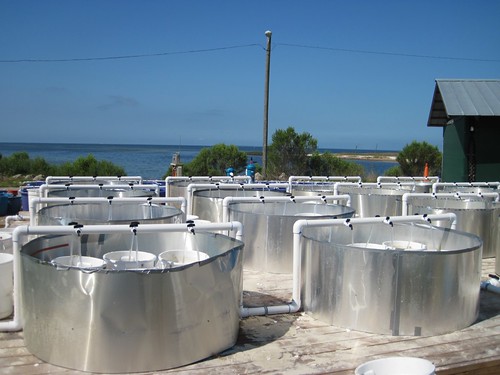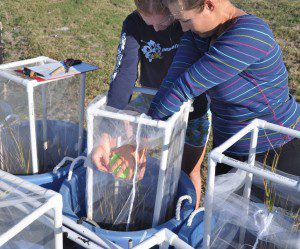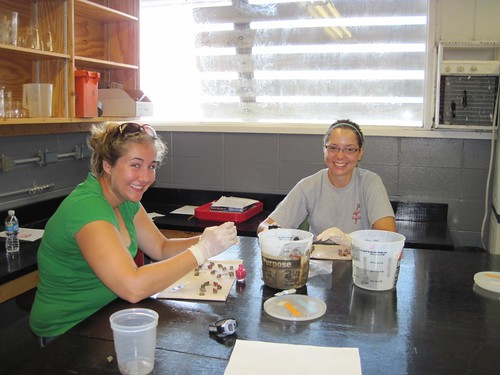Dr. Randall Hughes FSU Coastal & Marine Lab
“Wow, quite the set-up! I am jealous of that space!
“…As a side question, how did you pump the cue water to all your tubs, a peristaltic pump? Was it just gravity? Seems like quite the complicated set-up.”
Excerpts from a comment on Randall’s September 28th post, Scared Hungry. Read the whole comment here.
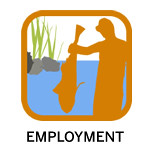 This recent comment by John Carroll made me realize that there are a lot of unsung heroes at the lab that don’t typically get credit for the essential work that they do to facilitate our research. So here is a ‘behind-the-scenes’ look at setting up an experiment:
This recent comment by John Carroll made me realize that there are a lot of unsung heroes at the lab that don’t typically get credit for the essential work that they do to facilitate our research. So here is a ‘behind-the-scenes’ look at setting up an experiment:
1. The idea. This is the main part that I can take credit for, though even then an idea usually stems not simply from my brain, but from a paper I’ve read, a conversation with a colleague or student, or an observation in the field.
2. The infrastructure. Each experiment has its own specifics, but in my research there are generally 3 main requirements:
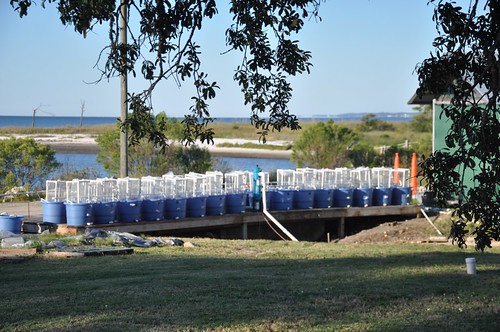
The "small" deck, used by David and me for mesocosm experiments with snails, crabs, plants, oysters - you name it!
a. Space. FSUCML has numerous tanks and related facilities for use in research (Visit the Lab site here.). Of course, I often have specific needs or desires, and thus my first step is usually to speak to Mary Balthrop, our Associate Director, and then to Dennis Tinsley, our Facilities Manager. Both Mary and Dennis show a great deal of good humor in receiving my seemingly hair-brained requests (e.g., a deck that can hold 16 plastic kiddie pools full of sand and water!), and they work with me to find (or devise) a suitable space to get the job done. Our incredible carpenter, Dan Overlin, then has the task of modifying or creating that space.
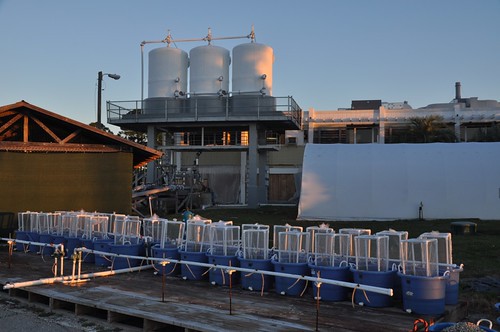
Another view of the small deck, with the large seawater tanks in the background. (Photo credit: Nancy Smith)
b. Seawater. Since we work with marine critters, access to seawater is critical. FSUCML pumps seawater from the bay in front of the lab into large holding tanks that feed the entire facility.
Mark Daniels and Bobby Henderson then create the plumbing system that gets that water where it needs to go. They know everything there is to know about PVC pipes, water filters, pumps – you name it! As I mentioned in my response to John, it was Bobby who came up with the incredible pump apparatus (and several subsequent revisions) that has enabled us to conduct several experiments examining the effects of predator cues on prey behavior.
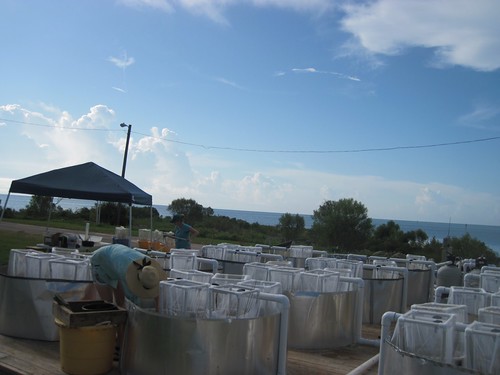
Robyn and Emily working to set up a recent experiment on the large deck. Although the plants love all the light, we decided to erect a tent as a refuge from the sun/heat.
c. Light. When working with plants, light is key. I’m fortunate to have access to a greenhouse, as well as abundant outdoor space at the lab to set up experiments. Or perhaps I should say once-abundant outdoor space, since David and my decks now cover a good chunk of it! Dennis is a pro at thinking of suitable and available spaces to squeeze in a few tanks.
3. The supplies. Once the infrastructure is in place, it’s time to buy the supplies needed to make each experimental unit. The job then falls to Kathy Houck and Maranda Marxsen to explain to the accountants at FSU why I purchased several large bolts of tulle fabric (grasshopper cages), or 24 pair of knee-high panty hose (they make great filters when filled with gravel), or lots and lots of nail polish (for marking snails). For field experiments, Sharon Thoman is helpful in arranging vehicles and boat reservations, sometimes at the very last minute!
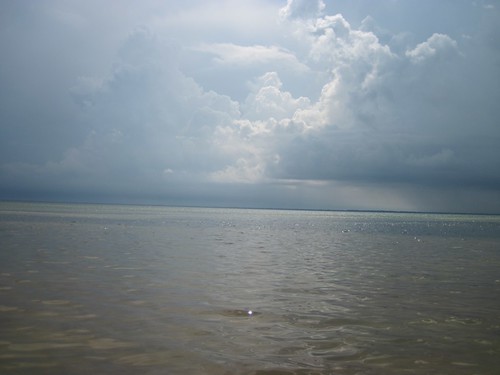
A thundercloud looms in the distance. Once this summer we were stranded in a storm and Dan came to retrieve us.
4. Set-up. Once things start to come together, there are inevitable surprises the crop up. In our recent predator-prey experiments, we had issues with flow from the pump being greater than that from the regular seawater lines, which required some brain-storming from Bobby, David, Kelly, Meagan, and myself. Or, a plumbing line will clog, and I’ll run to find Mark. Or, we’ll get stranded in a thunderstorm while collecting mud crabs and Dan will come pick us up. At least we often provide fodder for funny stories!
5. The experiment. And at last, the actual experiment can begin. When I come up with particularly high-maintenance experiments, it’s useful to utilize the lab dorms for the night. Linda Messer is always understanding of last minute housing requests and changes, making sure the lights (and, more importantly, the A/C) are on! Sometimes, the experiment itself is much shorter than the time required to set it up – duration never seems to equate with complexity. But one of the benefits of consulting with the staff is to ensure that the same space can be used for multiple purposes. And the second experiment is always easier to set up than the first!

